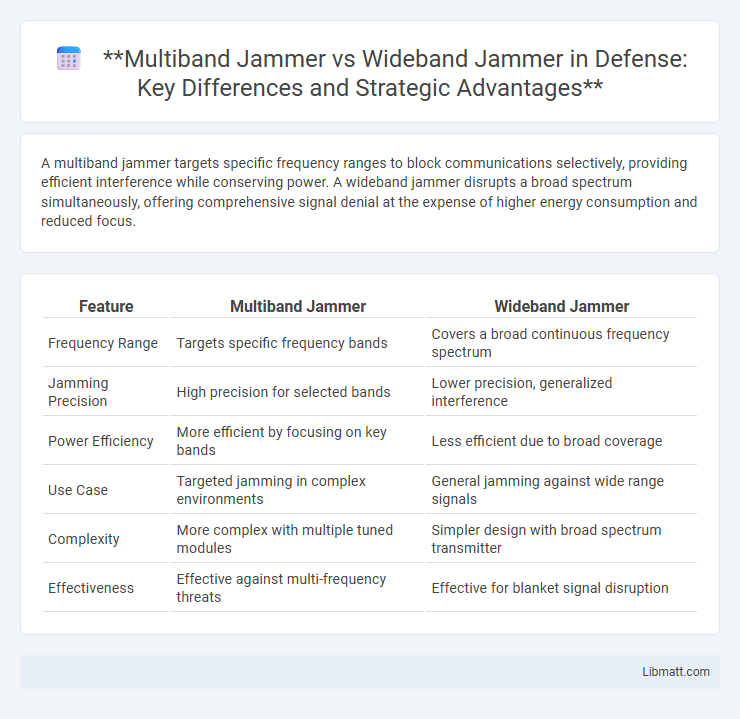A multiband jammer targets specific frequency ranges to block communications selectively, providing efficient interference while conserving power. A wideband jammer disrupts a broad spectrum simultaneously, offering comprehensive signal denial at the expense of higher energy consumption and reduced focus.
Table of Comparison
| Feature | Multiband Jammer | Wideband Jammer |
|---|---|---|
| Frequency Range | Targets specific frequency bands | Covers a broad continuous frequency spectrum |
| Jamming Precision | High precision for selected bands | Lower precision, generalized interference |
| Power Efficiency | More efficient by focusing on key bands | Less efficient due to broad coverage |
| Use Case | Targeted jamming in complex environments | General jamming against wide range signals |
| Complexity | More complex with multiple tuned modules | Simpler design with broad spectrum transmitter |
| Effectiveness | Effective against multi-frequency threats | Effective for blanket signal disruption |
Introduction to Jamming Technologies
Multiband jammers target specific frequency bands, effectively disrupting multiple communication channels such as cellular, Wi-Fi, and GPS without affecting the entire spectrum. Wideband jammers, by contrast, broadcast noise across a broader frequency range, causing widespread signal interference but consuming more power and risking collateral disruptions. Both technologies serve critical roles in electronic warfare and security, with multiband jammers offering precision and efficiency while wideband jammers provide comprehensive coverage.
Understanding Multiband Jammers
Multiband jammers target multiple frequency bands simultaneously, effectively disrupting various communication signals such as cellular, Wi-Fi, and GPS within specific ranges. Unlike wideband jammers that cover a broad spectrum but with limited power per frequency, multiband jammers concentrate their energy on selected frequency bands for more efficient signal interference. This focused approach enhances the jammer's effectiveness in environments requiring targeted disruption across distinct communication technologies.
Overview of Wideband Jammers
Wideband jammers emit signals across a broad frequency spectrum, disrupting multiple communication channels simultaneously to prevent detection and transmission. These devices are effective against diverse systems such as cellular networks, GPS, and Wi-Fi, offering comprehensive coverage in contrast to multiband jammers that target specific frequency bands. Your choice of a wideband jammer ensures robust interference across various signals, enhancing electronic countermeasure capabilities in complex environments.
Key Differences Between Multiband and Wideband Jammers
Multiband jammers target specific frequency bands, effectively disrupting communications within designated ranges such as cellular, Wi-Fi, or GPS signals, offering precision and reduced interference with non-targeted frequencies. Wideband jammers cover a broad spectrum, emitting noise across a wide range of frequencies simultaneously, which can prevent all signals within that spectrum but may cause unintended disruptions and consume more power. Your choice between multiband and wideband jammers depends on whether you need focused jamming with efficiency or broad-spectrum coverage at the cost of increased power usage and potential collateral interference.
Frequency Coverage and Selectivity
Multiband jammers target specific frequency bands, offering precise selectivity to effectively disrupt designated signals across multiple channels without affecting unrelated frequencies. Wideband jammers cover a broad spectrum, providing extensive frequency coverage but with less selectivity, which may result in interference with non-targeted signals. Your choice depends on whether you prioritize focused disruption of particular frequencies or broad suppression across a wide range.
Power Efficiency and Range Comparison
Multiband jammers target specific frequency bands, optimizing power use by concentrating energy where interference is most needed, which enhances power efficiency and extends effective jamming range within those bands. Wideband jammers spread energy across a broad spectrum, reducing power density per frequency and often resulting in lower efficiency and shorter range compared to focused multiband devices. Understanding these differences helps you select the ideal jammer configuration for your specific operational range and power constraints.
Applications in Civilian and Military Sectors
Multiband jammers target specific frequency ranges, making them ideal for civilian applications like protecting sensitive areas from unauthorized drone or cell phone communication without affecting all signals. Military sectors utilize multiband jammers to disrupt select enemy communication and radar signals with precision, minimizing collateral interference to friendly forces. Wideband jammers cover a broad spectrum, proving effective in military operations requiring comprehensive signal suppression, such as battlefield electronic warfare and counter-IED measures, but risk causing unintended disruption in crowded civilian environments.
Strengths and Limitations of Each Jammer Type
Multiband jammers offer targeted interference across specific frequency ranges, making them highly effective for disrupting multiple, known communication channels while conserving power. Wideband jammers cover a broad spectrum simultaneously, providing comprehensive signal disruption but often require more energy and may cause unintended interference with non-targeted systems. Your choice depends on whether precision or scope is prioritized in the jamming operation.
Choosing the Right Jammer for Specific Needs
Multiband jammers target specific frequency ranges, providing precise disruption ideal for environments where you need to block selective signals without affecting others, making them efficient for tailored security applications. Wideband jammers cover a broad spectrum, offering comprehensive signal blocking that suits areas requiring extensive interference across multiple frequencies simultaneously. Choosing the right jammer depends on your operational requirements: use multiband for focused control and energy efficiency, while wideband suits situations demanding maximum coverage and signal denial.
Future Trends in Jamming Technology
Future trends in jamming technology emphasize increased adaptability and spectral efficiency, with multiband jammers advancing to target specific frequency ranges more precisely, reducing collateral interference. Wideband jammers are evolving to encompass broader spectrum coverage, leveraging AI-driven algorithms for real-time signal identification and disruption across diverse communication channels. Integration of machine learning and cognitive radio technologies is key to enhancing jamming accuracy, resilience, and autonomous operational capabilities in dynamic electromagnetic environments.
multiband jammer vs wideband jammer Infographic

 libmatt.com
libmatt.com